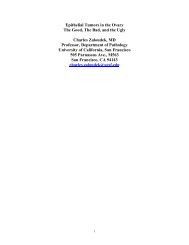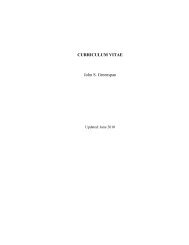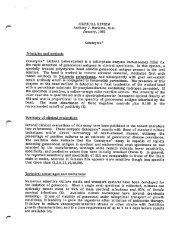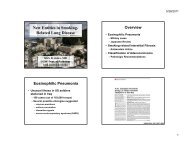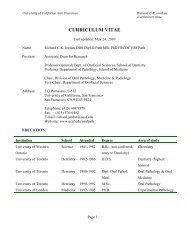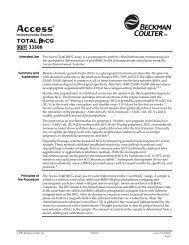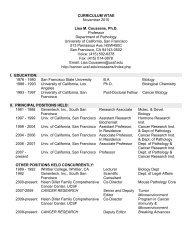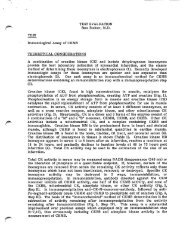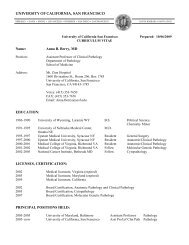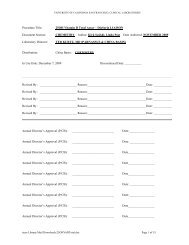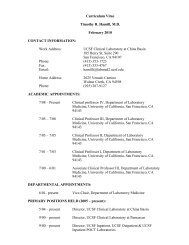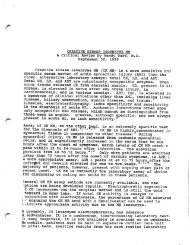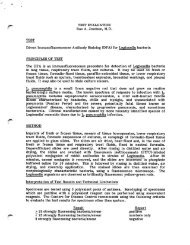Pinworm Examination
Pinworm Examination
Pinworm Examination
Create successful ePaper yourself
Turn your PDF publications into a flip-book with our unique Google optimized e-Paper software.
PURPOSE<br />
Director Approval ___________________________ Date 5/15/2011_______<br />
Clinical Laboratories<br />
Point of Care<br />
Testing<br />
MICROSCOPIC EXAMINATION FOR PINWORM<br />
Enterobiasis is best diagnosed by microscopic examination of specimens taken from the perianal<br />
region to identify Enterobius Vermicularis eggs or adult female worms if present.<br />
SCOPE<br />
The procedure is performed in the Hospital and Ambulatory settings by Medical Doctors and<br />
Nurse Practitioners who have been trained and maintain annual competency in this procedure.<br />
PERSONNEL<br />
• Licensed Medical Doctors<br />
• Licensed Advanced. Health Practitioners<br />
REAGENTS, EQUIPMENT AND MATERIALS<br />
SWUBE ® Paddle Method<br />
• SWUBE ® Paddle (TM of Becton-Dickinson and Co.)<br />
• Clean sterile glass slides<br />
• Microscope with low power objective<br />
Quality Assurance/POCT/POCT-Procedures/PPM Microscopic Exam for <strong>Pinworm</strong> ver. 1.1 2010_11 1 of 3
SPECIMEN REQUIREMENTS<br />
• Specimens are labeled with two forms of patient identification<br />
• Specimen must be collected at night or first thing in the morning before a bowel movement<br />
or bath.<br />
• Female pinworms deposit eggs sporadically so specimens must be collected on at least four<br />
consecutive days to rule out a false negative result.<br />
QUALITY CONTROL<br />
N/A<br />
PROCEDURE<br />
SWUBE ® Paddle Method<br />
1. Hold paddle by the cap and remove from tube.<br />
2. Press sticky surface to the right and left perianal folds.<br />
3. Replace the paddle in the tube until microscopic examination.<br />
4. Place the paddle on a slide.<br />
5. Using a microscope, examine the entire paddle for eggs or female adults under the low<br />
power objective.<br />
RESULTS AND REPORTING<br />
<strong>Pinworm</strong> eggs are elongate and flattened on one side, with a thick colorless shell.<br />
The adult female pinworms may also be seen on the tape preparation. They are characterized by<br />
a long, pointed tail.<br />
• Report as “Positive” – Enterobius Vermicularis ova or adults present.<br />
• Report as “Negative” – No Enterobius Vermicularis ova or adults present<br />
• Record the results in the patient’s Medical record chart.<br />
• Include the date/time and name of person performing the test.<br />
ALTERNATIVE TEST METHODS<br />
Test is performed in the Clinical Laboratory.<br />
RECORDS MAINTENANCE<br />
• Individual patient results are kept in their medical record charts indefinitely.<br />
REFERENCES<br />
Quality Assurance/POCT/POCT-Procedures/PPM Microscopic Exam for <strong>Pinworm</strong> ver. 1.1 2010_11 2 of 3
• Smith, J., and Gutierrez, Y., Todd-Stanford-Davidsohn Clinical Diagnosis and Management<br />
by Laboratory Methods, 17 th ed., W.B. Saunders Co., Philadelphia, 1984, pp. 1216-17,<br />
1245.<br />
• Ash, L. and Orihel, T., Manual of Clinical Microbiology, 6 th ed., American Society for<br />
Microbiology, Wash. D.C., 1995, pp. 1152,1229.<br />
• SWUBE ® Paddle Product insert. Becton-Dickinson and Co., 1986<br />
Quality Assurance/POCT/POCT-Procedures/PPM Microscopic Exam for <strong>Pinworm</strong> ver. 1.1 2010_11 3 of 3



